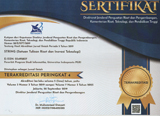Model Matematika Kanker Paru-paru Akibat Pengaruh Sisa Asap Rokok dan Pencegahannya
(1) Program Studi Informatika, Universitas Indraprasta PGRI
(*) Corresponding Author
Abstract
Keywords
Full Text:
PDF (Indonesian)References
A. Acevedo – Estefanía, Carlos, et al. (2000). A Mathematical Model for Lung Cancer: The Effects of Second-Hand Smoke and Education. BU-1525-M, Agustus 2000. 521 – 548.
American Association for Cancer Research (AACR). (2013). Diakses dari AACR website: http://www.aacr.org/AdvocacyPolicy/GovernmentAffairs/Documents/AACRStatement_TobaccoUseCancerPat
American Lung Association. (2009). Diakses dari website:
http://www.lung.org/lung-disease/lung-cancer/resources/facts-figures/lung-cancer-fact-sheet.html#1
Brauer, Fred and Carlos Castillo-Chavez. (2011). Mathematical Models in Population Biology and Epidemiology (2nd ed.). New York: Springer
Centers for Disease Control and Prevention. (2009). Diakses dari CDC website: http://www.cdc.gov/mmwr/preview/mmwrhtml/mm6347a4.htm?s_cid=mm6347a4_w.
Castillo-Garsow, Carlos, et al. (1997). Mathematical Models for the Dynamics of Tobacco Use, Recovery, and Relapse. BU-1505-M, Januari 1997. 17 – 44.
International Agency for Research on Cancer (IARC). (2012). Diakses dari IARC website: http://globocan.iarc.fr/Pages/fact_sheets_population.aspx
Jones, James Holland. (2007). Notes On . Departement of Anthropological Sciences, Stanford University.
Munir, Rinaldi. (2015). Metode Numerik. Edisi ke – 4. Bandung: Informatika
World Population Prospects – UN DESA – the United Nations. (2015). Diakses dari website: http://esa.un.org/unpd/wpp/Publications/Files/Key_Findings_WPP_2015.pdf, hal 5.
DOI: http://dx.doi.org/10.30998/string.v2i1.1734
Refbacks
- There are currently no refbacks.
Copyright (c) 2017 STRING (Satuan Tulisan Riset dan Inovasi Teknologi)
STRING (Satuan Tulisan Riset dan Inovasi Teknologi) indexed by:

Ciptaan disebarluaskan di bawah Lisensi Creative Commons Atribusi 4.0 Internasional.
View My Stats

 Sertifikat Akreditasi
Sertifikat Akreditasi
















